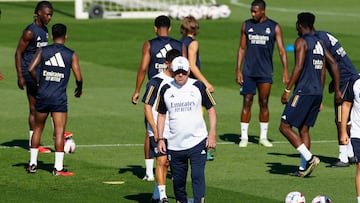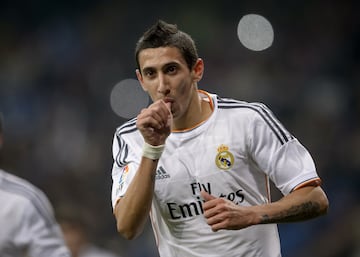REAL MADRID
Carlo Ancelotti’s Real Madrid’s tactical innovations as head coach
Carlo Ancelotti has already made some innovative tactical decisions that have paid off in the early stages of the 23/24 season.

Real Madrid, under Carlo Ancelotti, are set to try out various tactical changes over the 23/24 season, given the hugely significant departures they have seen during the summer transfer window. This is something Ancelotti is very much used to as a manager.
“It’s not easy to be so flexible and so chameleonic as he has been over his career... he’s not just a people-manager, but a person who on a tactical level has brought a lot to the sport. He’s always been good with the players, it’s one of his qualities, but he has a lot of football knowledge.” These are the words of Ancelotti about Ancelotti.
Davide, of course, Carlo’s son, in an interview with AS. It was back in December, before the goodbye from Benzema and the arrival of Bellingham. And it is the arrival of the Englishman that has put into view Carlo Ancelotti’s tactical understanding: playing the midfielder as a second striker has been a revelation.
It is not the first time that the manager has reinvented and improvised. The coach has two stints at Madrid and ten trophies to his name at the club, as well as various innovations on the field.

Jude Bellingham: a number 10
Ancelotti did not doubt himself when he told of how the new-look Real Madrid would perform without Benzema and with Bellingham. The physical, technical and tactical qualities of the Birmingham-born midfielder signalled to Carlo that he was more than just a midfielder.
The Italian understood instantly that Jude was able to have an impact as a playmaker, despite having won over the world as an inside midfielder. A box-to-box player was spoken about, too, but Ancelotti decided that playing off the striker was the best and most productive option.
Pre-season centred around working out the mechanisms that allowed the team to function around Bellingham and after just two games, the supporters already noticed the genius of the decision. Three goals in two games for Jude and, apart from the numbers, feelings that the player is genuinely special. “I’m ten times the player I was last season”, Bellingham has already claimed, despite having scored 14 goals last season for Dortmund.
Camavinga at left-back
Ferland Mendy’s physical problems coupled with Ancelotti’s decision to play Alaba as a centre-back left Real Madrid in a complicated situation at left-back. Nacho’s versatility was an option but it was never the first option... and then along came Camavinga.
The Frenchman had, admittedly, occupied the position before, but only ever in a worst-case scenario situation, and was deployed in that role for France in the World Cup. However, it was Carlo Ancelotti who utilised Camavinga as a full-time left-back and converted him in the undisputed starter in the role.
In one season he played 59 times (3,579 minutes) and 17 of those (1,422 minutes) were at the position on the left of the defensive line, about which he said “of course I’m not a left-back, I’m a centre-midfielder”. Strong in the battles, quick to adapt and a good relationship with Vinicius all helped the player fit into his new role. Sometimes he had imperfect positioning, but his performances were always positive.
However, if his progression continues as it is predicted, Camavinga’s time at left-back should be a side note in the history books. Both the club and Carlo Ancelotti both believe that the player is destined, as he would want, for a midfield role in the side. However, the option is always there for the Frenchman - and Ancelotti.
Valverde as a right-sided player
One of the keys to Real Madrid’s 14th Champions League success was the conversion of Valverde. The player, with Kroos, Modric and Casemiro in the side, had trouble finding his way into the starting lineup - until Ancelotti turned him into a false-7. He became a fourth midfielder who helped Carvajal in defence (remember Chelsea in the Champions League?) yet aided Vini Jr and Benzema in attack, even providing the match-winning assist for the Brazilian’s goal in the final.
And let’s not forget his shooting: a long-range specialist, Fede can trouble any goalkeeper from distance and the Uruguayan got 12 goals last season with plenty from outside the box. Despite his dip in form and goals in the post-World Cup part of the season, Fede continued to perform and has started the 23/24 campaign in fabulous fashion. He is slightly further away from goal now in the 4-3-1-2 that Madrid are using, putting him back where it all started in the engine room.
Now, however, the reality is there to see: Valverde is an undisputed starter for the manager. For both his intangible and very tangible qualities, the support the player gives on the pitch is palpable at Real Madrid.
Vinicius takes on a new role
In the never-ending will-he-won’t-he story of Hazard, Vini Jr appeared - and stayed. The 21/22 season was the final stretch of the climb to the top of the mountain for the player who has not dropped his level since, and curiously it was the first season of Ancelotti 2.0 at Madrid.
A substitute in his first two seasons at the club, Vinicius scored against Alavés and Almería, causing Carlo to take note and play him over Hazard, where he has not looked back. Vini himself has not stopped, and finished that season with 22 goals and 20 assists; last year he went one better, ending the campaign with 23 goals and 21 assists, as well as marking himself out as the undisputed leader of the team on the pitch.
“Vinicius is the most dangerous player on the planet”, said Ancelotti himself after the Brazilian tore Liverpool apart at Anfield. Now the claims remain undisputed, and the explanation is clear: before Ancelotti he scored 14 goals; after, he has 46.

Ángel Di María: the fourth member of the BBC
Gareth Bale arrived at Real Madrid in September of 2013 and the BBC - Bale, Benzema and Cristiano - was formed. However, a certain Ángel Di María was also there, and looked set to be shunned given the huge investment in his position. However, Di María’s superb football meant that Ancelotti had no other option but to find a place for him in the side and apart from being the immediate substitute for any absence in the front line, the Argentine was a revelation in the middle of the pitch.
Di María played almost as many games in central midfield (22) as he did in the front three (29) during the season in which Real Madrid win the coveted décima - their tenth European Cup in 2014. Xabi Alonso, Modric and Di María himself formed a unique but deadly partnership in midfield that connected the ferocious front three to the rest of the team.
His single season as a hybrid player saw him get 11 goals and 26 assists, as well as playing a key part in both the Champions League and Copa del Rey finals.






